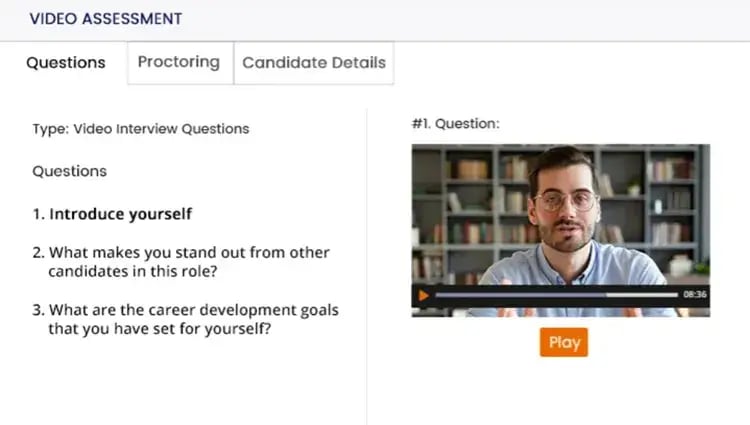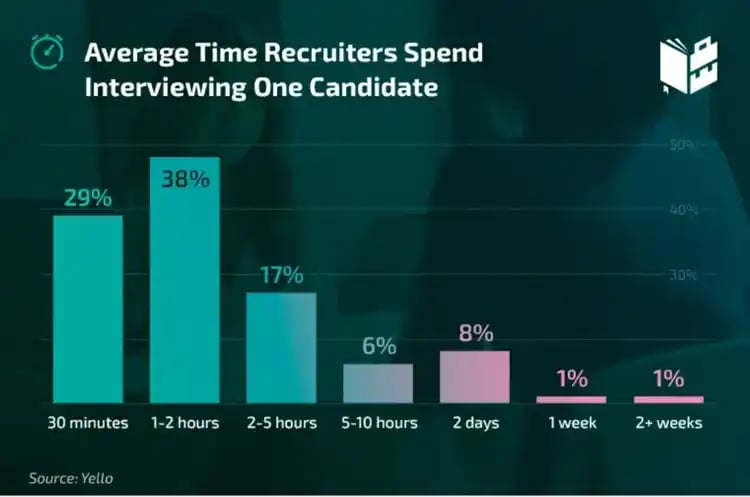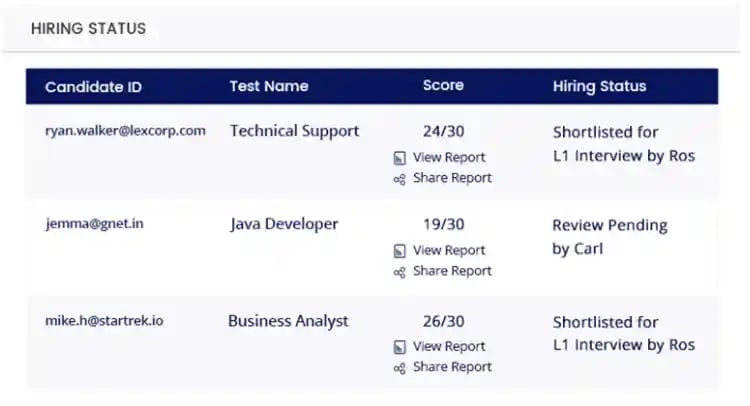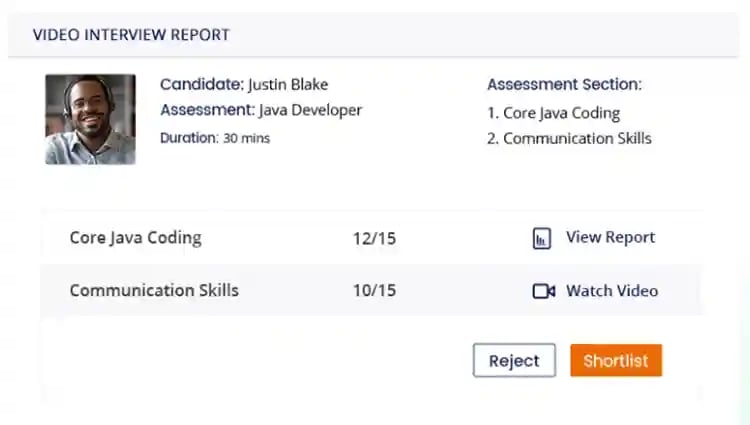According to HR Brew research, 61% of recruitment and HR technology leaders reported that their organization is currently utilizing one-way video technology. Using this feature, they ask candidates to submit a short video of themselves to the panel in order to be considered for the next round.
Why are employers doing this?
Due to the current job market, employers are experiencing an unprecedented influx of resumes and applicants, leaving them with the daunting task of sorting through an overwhelming number of interviews.
This tedious process is time-consuming, requiring recruiters to contact each applicant individually. With more positions open than unemployed workers, the recruitment process has become an arduous job in itself.
The challenge does not end there; to further complicate the process:
- Candidates constantly search for better opportunities just before starting
- Rearranging or canceling interviews
- Ghosting or dropping out unexpectedly
To sort through the deluge of applicants, many employers utilize one-way interviews to provide employers with an efficient, convenient way to engage with candidates while streamlining the recruitment process.
In this article, we'll help you understand how one-way video interview works and its impact on streamlining recruitment.
So, let's get started!
What is the difference between a video interview and a one-way video interview?
A typical video interview is one in which employers and applicants communicate face-to-face via webcam. It is also known as a 2-way interview where the employer asks the questions and the job seeker responds.
In contrast, a one-way video interview is often a short-recorded interview. One-way video interviews, also known as asynchronous interviews, are typically used to help employers quickly assess the skills, qualifications, and experience of a larger number of applicants.
What is a one-way video interview?
Consider the following scenario:
You are recruiting for a position and have selected a few individuals for interviews.
You are now doing back-to-back video interviews with n number of prospects.
Following that is a follow-up meeting in which the candidates attempt to recall key details from each conversation and evaluate the applicants.
Well, asynchronous video interviews mean you can assess all the candidates simultaneously and provide feedback or share insights in real-time.
 Therefore, in this interview type, only the candidate has to be available for the interview. Unlike traditional real-time interviews, a candidate must record his or her responses to the questions and submit them to the respective organization.
Therefore, in this interview type, only the candidate has to be available for the interview. Unlike traditional real-time interviews, a candidate must record his or her responses to the questions and submit them to the respective organization.
Now you must be wondering why one-way interviews are called asynchronous video interviews.
Well, because the applicant and the interviewer never meet. At least not throughout the interview process. Rather than participating in a series of video chats, the candidate records answers to pre-determined questions set by your recruiting team.
So, how does a one-way video interview work?
Well, here are some points on how does a one-way video interview work:
- It can be completed from anywhere and at any time before the deadline.
- It can be easily accessed using the test link.
- In order to help candidates comprehend the questions they are to answer, the questions will be displayed on the screen.
|
Do you know companies like Hexaware, Deloitte, TCS, and more reduced their hiring time by 70% using the automated video interview feature of iMocha? Want to find out how! |
Do one-way video interviews provide effective results?
Yes, one-way video interview does offer effective results for specific job types.
Let's understand it this way!
Do you know how much time average recruiters spend interviewing one candidate?
 According to Forage, an average recruiter spends about 30 to 45 minutes on a call with each candidate.
According to Forage, an average recruiter spends about 30 to 45 minutes on a call with each candidate.
So, if a recruiter conducts 8 interviews a day, he/she will be spending an average of 240 minutes asking and evaluating the same skill set of different potential employees.
Now, one-way interview enables recruiters to make this entire interviewing process seamless.
Using this method, you can screen thousands of applicants to determine if you should move to the next round of interviews. Additionally, it provides an opportunity to give detailed feedback and scores on factors such as confidence, soft skills, and qualifications to determine the best candidate for the job.

Here are some more points on how does a one-way video interview works for recruiters effectively:
- Using this interview approach, recruiters can quickly assess prospects on various factors.
- A hiring manager can watch the video whenever it is convenient for them and share it with other managers.
- Every candidate has to answer the same set of questions, which ensures a fair hiring process.
- It enables recruiters to screen more job candidates for skills that cannot be assessed only through resumes.
- It reduces geographic barriers and broadens access to prospects, which is an excellent feature for remote workers.
- It also aids managers' memory by comparing responses from different candidates' side by side.
- This method eliminates implicit bias.
Here are some points on how does a one-way video interview works for candidates effectively:
- It allows applicants to introduce themselves at greater length.
- It assists applicants in demonstrating their other abilities.
- It enables applicants to save travel time and money.
- It provides them with more control over where they interview.
How to conduct a one-way video interview?
If you want to do a one-way video interview, you should use the right software to assist you in narrowing down your instructions so that applicants understand and record the best on-demand interview.
If you are wondering which tool to utilize, try incorporating iMocha into your recruitment process.
This AI-powered skills assessment tool provides skill-based talent analytics to help employers make more informed recruiting decisions. Using its extensive skill library with over 2500+ skills, 100+ IT skills, 77+ domain skills, and more, you can assess candidates on a variety of skill sets.
This tool offers a variety of question types, such as fill-in-the-blanks, multiple choice, audio-video, live coding, and whiteboarding. Furthermore, its one-way interview feature enables you to construct a well-organized and structured interview process, that is:
- Fair
- Objective
- Devoid of biases
You can use this tool to invite a large number of candidates according to the preferred schedule via a link. Once the candidate's response is recorded, it is immediately sent to the recruiter's desk for assessment.
Some of the top features of iMocha's one-way interview tool are:
- Allows candidates to practice with a demo question
- Creates a set time limit and maximum number of retakes
- It enables you to assess candidates in a role and gather insights into how they approach specific situations.
- Make informed decisions after a thorough analysis
 Additionally, iMocha has the most powerful AI-enabled proctoring suite that identifies test cheating. It detects candidates indulging in malpractices from the test window, captures real-time images through the webcam, and secures the test environment via IP lock and window lock.
Additionally, iMocha has the most powerful AI-enabled proctoring suite that identifies test cheating. It detects candidates indulging in malpractices from the test window, captures real-time images through the webcam, and secures the test environment via IP lock and window lock.
|
Struggling to identify top candidates? Discover how iMocha can help you hire high-performing candidates while maintaining the organizational skills bar. |
How to plan one-way video interview questions?
When considering whether to include one-way interviews in your hiring process, consider the role you're interviewing for, the number of prospects you expect, and how those candidates will go through the pipeline.
You should also determine how long applicants have to answer questions before recording, how many attempts they may make, and the duration of the recording.
After you've considered these variables, you'll be able to identify which element of your hiring process is most suited for one-way interviews.
What types of questions are commonly asked in a one-way interview?
In typical video questions, candidates are asked questions like:
- To introduce themselves
- Talk about previous experience
- Talk about future goals
- Describe strengths/weaknesses
- How have you handled a difficult situation in your previous employment
What are the benefits of introducing a one-way video interview in the hiring process?
The one-way video interviews are beneficial to organizations as:
- Flexibility: With its flexibility over scheduling conflicts, this system allows you to create a list of questions and allows applicants to submit their video responses whenever convenient for them.
- Remove geographical boundaries: It allows you to source talent from beyond your local area, giving you access to a much wider and more diverse pool of potential hires.
- Make informed decisions: It lets you view all videos simultaneously. Because all applicants answer the same questions, you can more readily determine which ones have the abilities you seek.
- Better exposure to showcase their skills: Candidates can also rerecord their responses and submit them only when they are satisfied, giving them some control over the impression they project.
- Cuts down the hiring time: Instead of calling each prospect individually, you can send bulk emails to them with a single click.
You can get more insights in our benefits of video interview platforms which will help you transform your hiring process.
|
Did you know that iMocha can help you reduce your hiring time from 17 days to 7 days per role? Speak to iMocha Experts! |
Are there any limitations to one-way video interviews?
Yes, there are certainly some limitations in this interviewing process. Some of the common limitations are:
- Lacks human connection: The one-way interview approach inhibits candidates' ability to ask questions and learn more about the firm.
- Limits company promotion: When it comes to attracting new talent, every contact is an opportunity to pitch them on the benefits of working for your company. However, the breadth of this interview procedure is limited.
- Limited personalized questions: One-way interviews limit the interviewer's ability to ask individualized questions about the candidate's background and personality.
Conclusion
Overall, one-way interviews have helped companies quickly and efficiently assess prospects. As it allows for quicker turnaround times, you can afford to provide a candidate you might not normally consider a second look and go deeper into your talent pool. This type of interview is an excellent approach to assess a candidate's potential and fit for the job, and it has the potential to make the recruiting process more cost-effective.
Check out these Top 10 Best Video Interviewing Software and Platforms for Virtual Interviews in 2024
FAQs
1.How does a one-way video call work?
A one-way video call allows recruiters to transmit a link to a video call recording. Candidates can answer the listed questions and upload a short video recording using the link. Recruiters can generally watch these video responses at their convenience.
2.What are the best practices while conducting one-way video interviews?
The best practices while conducting one-way video interviews are as follows:
- Choose an optimum one-way video interview tool
- Create a question bank addressing all the questions you would like to ask the candidate
- Narrow down your question to not make the initial stage of the hiring process lengthy
- Write down all the necessary instructions for candidates to follow during the interview process.
- Set a test time frame
- Generate a test link that can be easily accessed using any web browser
3.When should you use one-way video interviews?
One-way video interviews can be used at the initial stage of the hiring process. This type of interview allows employers to review a large number of applicants quickly and efficiently and can be used to determine which applicants are best suited for the job.

